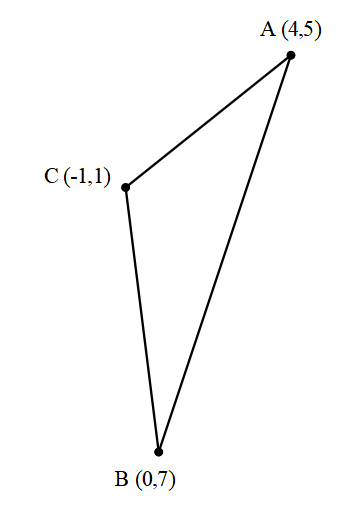Question
Question: Find the area of the triangle whose vertices are (4,5), (0,7), (-1,1)....
Find the area of the triangle whose vertices are (4,5), (0,7), (-1,1).
Solution
In order to solve this problem, we need to use the formula of area of a triangle using the vertices of the triangle. The formula for the area of the triangle is given by S=21[x1(y2−y3)+x2(y3−y1)+x3(y1−y2)] , where, (x1,y1),(x2,y2),(x3,y3) are the coordinates of the three vertices of the triangle. The units of the area are assumed to be square units.
Complete step-by-step answer:
We need to find the area of the triangle. For the area of the triangle, we need to find the sides of the triangles.
For a better interpretation, we need to draw a rough sketch of the triangle.
The figure is as below,

Let the triangle be ABC with vertices A (4,5) , B (0,7) , C (-1,1).
Let, the coordinates of A be A(4,5)=A(x1,y1) .
Let, the coordinates of B be B(0,7)=B(x2,y2) .
Let, the coordinates of C be C(−1,1)=C(x3,y3) .
The area of the triangle (S) is given by S=21[x1(y2−y3)+x2(y3−y1)+x3(y1−y2)]
Where, (x1,y1),(x2,y2),(x3,y3) are the coordinates of the three vertices.
We can substitute the values and find the answer to the area of the triangle.
Substituting we get,
S=21[4×(7−1)+0×(1−5)+(−1)(5−7)]
Simplifying further we get,
S=21[4×6+0+(−1)(−2)]=21[24+2]=21×26=13
Therefore, the area of the triangle is 13 square units.
Note: We need to note that we can start naming coordinates from any coordinates the answer we get will be the same. Even if we get the answer negative we only need to take the positive values because the area cannot be negative ever. Also, as we have not given the units we will assume the units to be square units.
